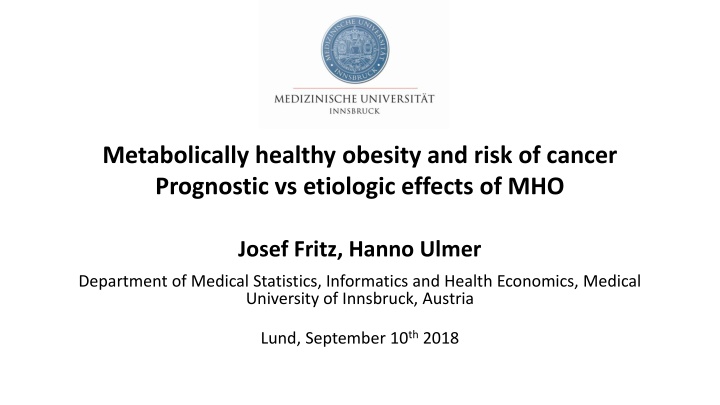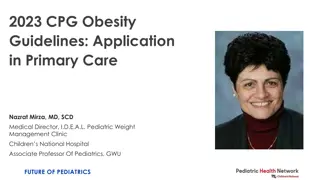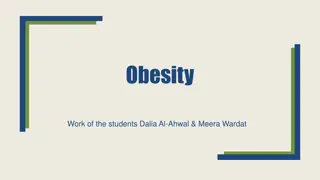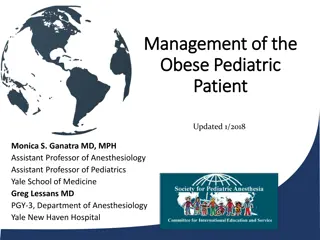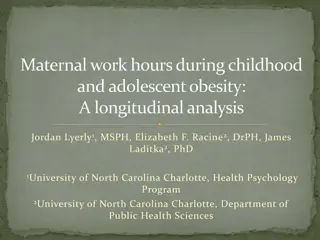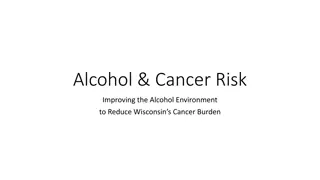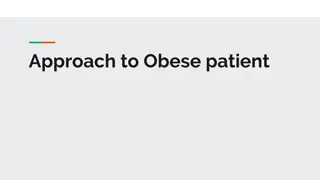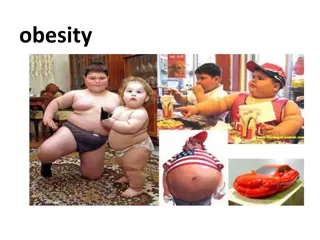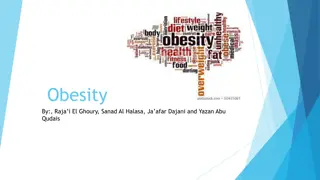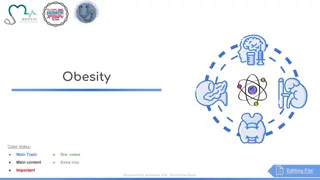Metabolically Healthy Obesity and Cancer Risk: Investigating the Link
Excess body weight is a known risk factor for cancer, but not all obese individuals exhibit metabolic abnormalities. This study explores the concept of metabolically healthy obesity (MHO) and its association with cancer risk, aiming to understand the unique patterns of risk transmission compared to cardiovascular disease. The analysis considers competing risks, such as death from other causes, and compares the use of Cox proportional hazards and Fine-Gray subdistribution hazards models in quantifying outcomes. The research distinguishes between etiologic and prognostic effects, shedding light on the complexities of obesity-related cancer risks.
Download Presentation

Please find below an Image/Link to download the presentation.
The content on the website is provided AS IS for your information and personal use only. It may not be sold, licensed, or shared on other websites without obtaining consent from the author.If you encounter any issues during the download, it is possible that the publisher has removed the file from their server.
You are allowed to download the files provided on this website for personal or commercial use, subject to the condition that they are used lawfully. All files are the property of their respective owners.
The content on the website is provided AS IS for your information and personal use only. It may not be sold, licensed, or shared on other websites without obtaining consent from the author.
E N D
Presentation Transcript
Metabolically healthy obesity and risk of cancer Prognostic vs etiologic effects of MHO Josef Fritz, Hanno Ulmer Department of Medical Statistics, Informatics and Health Economics, Medical University of Innsbruck, Austria Lund, September 10th2018
Introduction Excess body weight/obesity is a major risk factor for many cancer forms However, there is a subgroup of obese people who present with few or no elevated metabolic risk factors the metabolically healthy obese (MHO) as opposed to the metabolically unhealthy obese (MUHO) Regarding the association of metabolic health (MH) status and BMI with cardiovascular outcomes, there is a large volume of literature 2
MHO and cardiovascular risk Results are in line with the assumption that a large part of the effect of BMI, but not all, is mediated throughmetabolic factors 3
MHO and cancer risk However, MHO has not yet been systematically investigated in cancer epidemiology The aim of this study is to exactly do this Because the mechanisms linking obesity and cancer are different from those linking obesity and CVD, we can expect that MH status shows different patterns in conveying risk of cancer than the patterns observed for MH status and cardiovascular risk 4
Competing risk analysis In prospective settings, the association of the outcome of interest in our case time to incident cancer is routinely quantified with Cox proportional hazards regression models Death from other (cancer-unrelated) causes is clearly a competing event to our event of interest Because MHO and MUHO individuals differ in their probability of suffering from a competing event, it is a natural idea to think about integration of the competing event information in the analysis -> Fine-Gray subdistribution hazards model 5
Cox vs. Fine-Gray model The effect size given by the Cox model, namely the HR, answers etiologic research questions (it compares the cause-specific hazard function irrespective of the competing events) therefore also the name cause-specific hazard model The effect size of the Fine-Gray model, the SHR (subdistribution hazard ratio), on the other hand, answers prognostic or medical decision-making research questions (it compares the CIFs) therefore also the name cumulative incidence function (CIF) regression 6
Example Cox vs. Fine-Gray model It is even possible that HR and SHR have different signs (i.e. >1 and <1 or vice versa) Example: Smoking increases the cause-specific risk (in terms of HR) of Alzheimer s disease However, the actual incidence rate (in terms of CIF) is lower because many smokers have already died of other causes before they can actually develop Alzheimer s disease 7
Aims of the study 1. To systematically quantify the association between obesity, MH status and cancer risk for various types of cancer (all cancers? only obesity-related cancers? cancer subgroups?) To do this analysis both from an etiologic (Cox) AND prognostic (Fine-Gray) standpoint 2. 8
Material and methods After exclusion of observations with missing or implausible information on relevant variables (in particular fasting status, BMI, glucose, triglyceride, blood pressure, cholesterol, smoking status), prevalent cancer or a follow-up less than twelve months, 509,963 baseline observations were left for analysis 60,443 individuals developed cancer during a median follow-up of 17 years Stratification of analyses by sex and cancer type, comparison of MH normal weight (reference) with MUH normal weight, MHO and MUHO Cumulative incidence functions (cancer events and competing events (death from other causes)) Cox models vs Fine-Gray models, using age as the underlying time variable, and excluding the first 12 months of follow-up after baseline 9
Definition of MHO (Lassale et al, EHJ 2018) Being metabolically unhealthy was defined as having three or more of the following metabolic abnormalities: I. elevated BP (SBP>=130 and/or DBP>=85mmHg) and/or use of antihypertensive medication II. hypertriglyceridaemia, defined as triglycerides >=1.7mmol/L (150mg/dL) or current use of lipid-lowering medication at baseline III. low HDL-cholesterol, defined as <1.0mmol/L (40mg/dL) for men and <1.3mmol/L (50mg/dL) for women IV. hyperglycaemia, defined as fasting blood glucose >=5.6mmol/L (100mg/dL) or non-fasting blood glucose>=7.8mmol/L (140mg/dL, with fasting defined as >=3 h between last meal and blood draw) and/or current use of antidiabetic medication V. elevated waist circumference, defined as WC>=94cm for men and WC>=80cm for women (Definition according to the 2009 Joint Interim Statement of the International Diabetes Federation Task Force on Epidemiology and Prevention; National Heart, Lung, and Blood Institute; American Heart Association; World Heart Federation; International Atherosclerosis Society; and International Association for the Study of Obesity) 10
Proposed definition of MHO in our study Being metabolically unhealthyis defined as having two or more of the following metabolic abnormalities: I. SBP>=160 and/or DBP>=95mmHg II. non-fasting (<8h) triglycerides >=2.3mmol/L (204 mg/dl) or fasting (>=8h) triglycerides >=1.7mmol/l (150mg/dl) III. total cholesterol >=6.2 mmol/L (241mg/dl) IV. non-fasting (<8h) blood glucose >=7.8mmol/L (141mg/dL) or fasting blood glucose>=5.6mmol/L (101mg/dl) Female (N=252,246) Male (N=257,717) High BP 23,895 (9.5%) 35,640 (13.8%) High TG 35,054 (13.9%) 80,655 (31.3%) High TC 62,019 (24.6%) 82,210 (31.9%) High BG 34,801 (13.8%) 47,698 (18.5%) MUH 36,665 (14.5%) 69,004 (26.7%) 11
Alternative definition of MHO in our study Calculate z-scores of logarithmized triglycerides, logarithmized glucose, cholesterol and mid blood- pressure stratified by sex, cohort, and fasting status Sum up these four scores and standardize again Being metabolicallyunhealthyis defined as being in the highest quartile (Q4) Female (N=252,246) Male (N=257,717) MUH 62,537 (24.8%) 64,155 (24.9%) 12
Preliminary results for obesity-related gastrointestinal cancers (1) Gastrointestinal cancers defined as ICD-9 codes 150-157 / ICD-10 C15-C25 A total of 6,604 cancers are included in this analysis CIF curves for males 13
Preliminary results for obesity-related gastrointestinal cancers (2) Gastrointestinal cancers defined as ICD-9 codes 150-157 / ICD-10 C15-C25 A total of 6,604 cancers are included in this analysis CIF curves for females 14
Gender comparison Males Females 15
Preliminary results for obesity-related gastrointestinal cancers Cause-Specific Hazard Model (Cox) Subdistribution Hazard Model (Fine-Gray) MHNW MHO MUHO MHNW MHO MUHO Males Ref 1.46 (1.30-1.63) 1.47 (1.33-1.63) Ref 1.35 (1.21-1.51) 1.24 (1.12-1.37) Females Ref 1.34 (1.18-1.51) 1.34 (1.21-1.49) Ref 1.24 (1.11-1.37) 1.22 (1.09-1.37) Each cell contains the hazard ratio / subdistribution hazard ratio and associated 95% confidence interval MHNW metabolically healthy normal weight; MHO metabolically healthy obese; MUHO metabolically unhealthy obese 16
Summary (regarding gastrointestinal cancers) As expected, prognostic effects (SHR) are somewhat smaller than etiologic effects (HR) for both MHO and MUHO In strong contrast to cardiovascular disease, cause-specific effects do almost not differ between MHO and MUHO It appears that obesity itself rather than metabolic risk factors is the main driver for increased cancer risk Because of competing risks, male MUHO are better off in regard to cancer risk than male MHO; probably caused by gender differences regarding CVD 17
